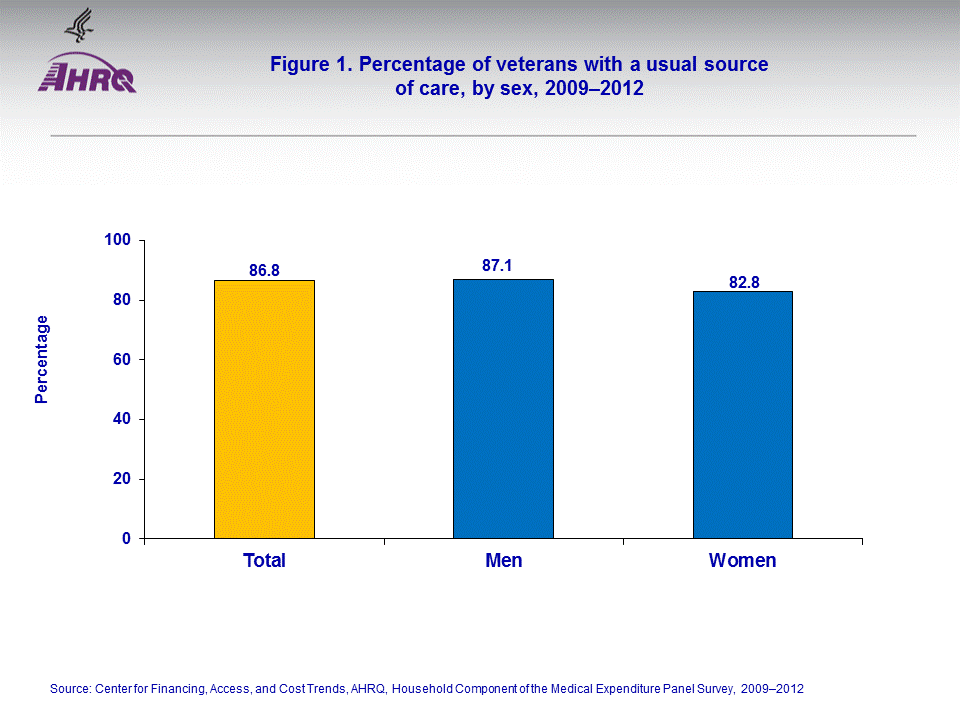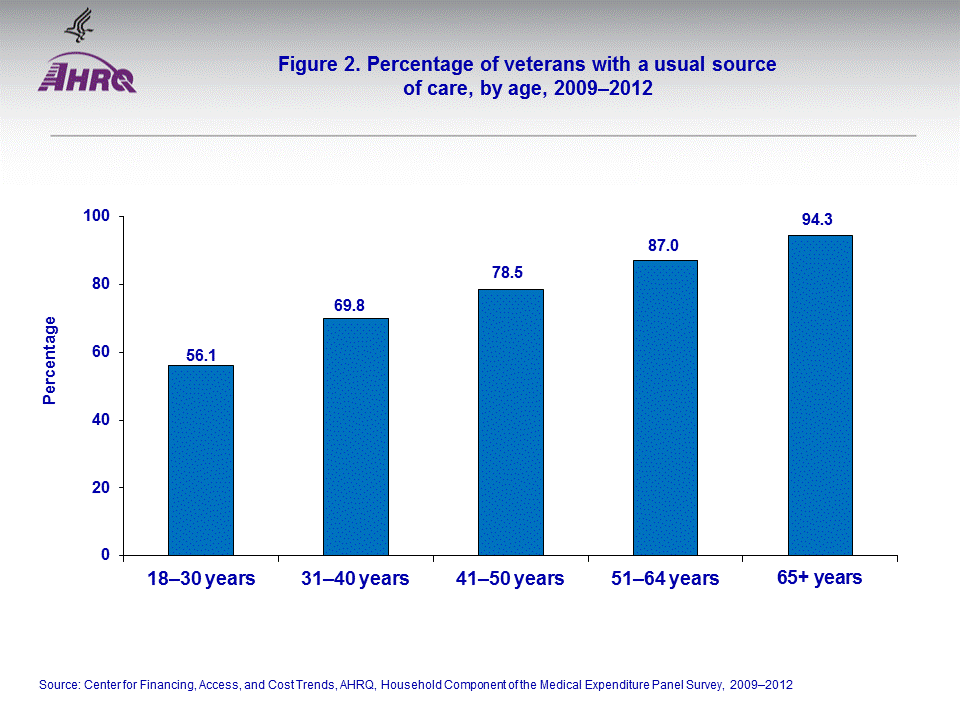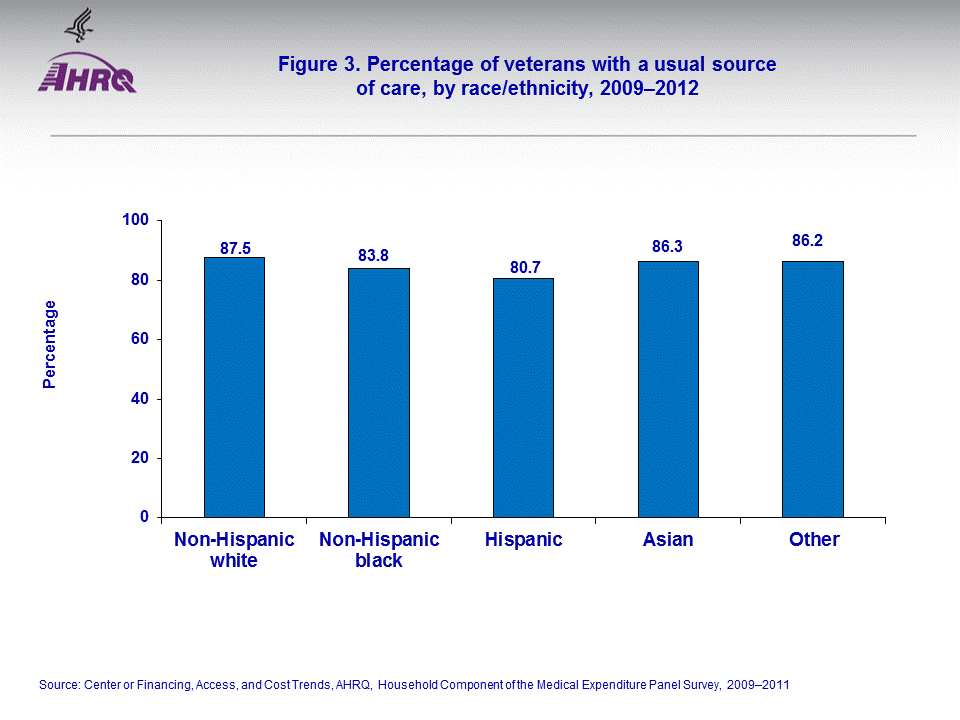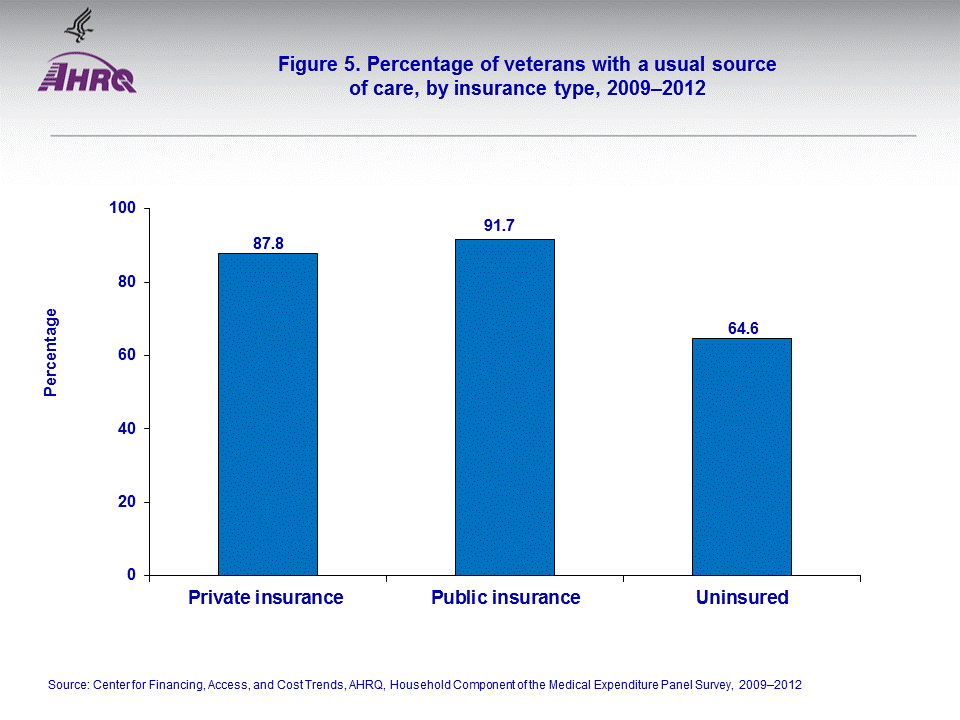
|
|
Font Size:
|
||||
|
|
|
|
||||
STATISTICAL BRIEF #479:
Veterans' Usual Source of Care, 2009-2012: Estimates for the U.S. Civilian Noninstitutionalized Population
Highlights
- During the years 2009-2012, 86.8 percent of veterans reported having a usual source of care.
- The percentage of veterans with a usual source of care increased with age.
- Veterans without health insurance were least likely to have a usual source of care compared to veterans with public insurance or private insurance.
Introduction
In 2013, there were 19.6 million veterans in the U.S. civilian noninstitutionalized population. Through the Department of Defense TRICARE insurance, military treatment facilities, or the Department of Veterans Affairs, the majority of these veterans have access to health care that is unavailable to many Americans. A widely used indicator for determining if a person has access to care is whether that person has a usual source of health care (USC). While there is well documented research identifying the sociodemographic characteristics that contribute to having access to care, less is known about veterans. Estimates of USC are critically needed to inform policy decisions concerned with access to health care and are crucial in improving access to care for veterans.Using information from the Household Component of the Medical Expenditure Panel Survey (MEPS-HC) for 2009–2012, this report provides detailed estimates of the percentage of honorably retired discharged veterans who reported having a USC in the U.S. civilian noninstitutionalized population. Annual estimates for USC for veterans for the pooled period 2009–2012 are presented by sex, age, race and ethnicity, poverty status, and type of health insurance. All differences between estimates discussed in the text are statistically significant at the 0.05 level. See table 1 for a demographic overview of the veteran population.
Findings
During 2009–2012, an annual average of 86.8 percent of veterans had a USC. Among veterans, men were more likely to have a USC (87.1 percent) than women (82.8 percent, see figure 1). As age increased, the probability of having a USC also increased (56.1 percent of veterans ages 18–30, 69.8 percent of veterans ages 31–40, 78.5 percent of veterans ages 41–50, 87.0 percent of veterans ages 51–64, and 94.3 percent of veterans age 65 and older (see figure 2). Non-Hispanic white veterans had a rate of having a USC (87.5 percent) that was higher than that for non-Hispanic blacks at 83.8 percent, and Hispanics at 80.7 percent (see figure 3).Veterans with high family income were more likely (88.8 percent) to have a USC than veterans with low family income (84.7 percent) and those who were poor or near poor (81.1 percent, see figure 4). When veterans were examined by health insurance status, uninsured veterans were least likely to be reported as having a USC (64.6 percent) compared to veterans with private insurance (87.8 percent) and public insurance (91.7 percent) (see figure 5). The difference in USC rates between veterans with private and public insurance was statistically significant.
Data Source
The estimates shown in this Statistical Brief are based on data from the following MEPS Full Year Consolidated Data Files from 2009–2012: HC-129, HC-138, HC-147, and HC-155. The sample is restricted to those veterans who answered the questions regarding USC (97 percent). Standard errors for all estimates are adjusted for complex survey design using the survey commands in Stata.Definitions
Usual source of careFor each individual family member, MEPS ascertains whether there is a particular doctor's office, clinic, health center, or other place that the respondent usually visits if he/she is sick or needs advice about his/her health.
Veteran
Individual who had ever been honorably discharged from active duty in the U.S. Army, Navy, Air Force, Marine Corps, or Coast Guard.
Race and ethnicity
Classification by race and ethnicity was based on information reported for each family member. Respondents were asked if each family member was Hispanic or Latino. Respondents were also asked which race or races best described each family member. Race categories included white, black/African American, American Indian or Alaska Native, Asian, Native Hawaiian or other Pacific Islander, and other. Based on these questions, sample persons were classified into the following race/ethnicity categories: Hispanic, black non-Hispanic single race, white non-Hispanic single race, Asian non-Hispanic single race and other (Hawaiian/Pacific Islander non-Hispanic, American Indian/Alaska Native non-Hispanic, and multiple races non-Hispanic).
Age
Age was defined as age at the end of the year.
Health insurance status
Individuals were classified in the following three insurance categories based on household responses to health insurance status questions:
- Any private health insurance: Individuals who, at any time during the year, had insurance that provides coverage for hospital and physician care (other than Medicare, Medicaid, or other public hospital/physician coverage) were classified as having private insurance. Coverage by TRICARE (Armed Forces-related coverage) was also included as private health insurance. Insurance that provides coverage for a single service only, such as dental or vision coverage, was not included.
- Public coverage only: Individuals were considered to have public coverage only if they met both of the following criteria: 1) they were not covered by private insurance at any time during the year, and 2) they were covered by any of the following public programs at any point during the year: Medicare, Medicaid, or other public hospital/physician coverage.
- Uninsured: The uninsured were defined as people not covered by private hospital/physician insurance, Medicare, TRICARE, Medicaid, or other public hospital/physician programs at any time during the entire year or period of eligibility for the survey.
Sample persons were classified according to the total yearly income of their family. Within a household, all people related by blood, marriage, or adoption were considered to be a family. Poverty status categories are defined by the ratio of family income to the federal income thresholds, which control for family size and age of the head of family. Poverty status was based on annual income.
Poverty status categories are defined as follows:
- Poor: Persons in families with income less than or equal to the poverty line; includes those who had negative income.
- Near poor: Persons in families with income over the poverty line through 125 percent of the poverty line.
- Low income: Persons in families with income over 125 percent through 200 percent of the poverty line.
- Middle income: Persons in families with income over 200 percent through 400 percent of the poverty line.
- High income: Persons in families with income over 400 percent of the poverty line.
| Sex | Men | 93.2% |
| Women | 6.8% | |
| Age | 18-30 years | 3.3% |
| 31-40 years | 7.9% | |
| 41-50 years | 13.4% | |
| 51-64 years | 29.4% | |
| 65 years and older | 46.0% | |
| Race/ethnicity | Non-Hispanic white | 82.4% |
| Non-Hispanic black | 9.9% | |
| Hispanic | 4.3% | |
| Asian | 1.2% | |
| Other | 2.2% | |
| Poverty status | Poor/near poor | 10.2% |
| Low income | 12.1% | |
| Middle income | 30.9% | |
| High income | 46.8% | |
| Insurance type | Uninsured | 7.4% |
| Public insurance only | 19.2% | |
| Any private insurance | 73.4% | |
About MEPS-HC
MEPS-HC is a nationally representative longitudinal survey that collects detailed information on health care utilization and expenditures, health insurance, and health status, as well as a wide variety of social, demographic, and economic characteristics for the U.S. civilian noninstitutionalized population. It is cosponsored by the Agency for Healthcare Research and Quality and the National Center for Health Statistics.For more information about MEPS, call the MEPS information coordinator at AHRQ (301-427-1406) or visit the MEPS Web site at http://www.meps.ahrq.gov/.
References
For a detailed description of the MEPS survey design, sample design, and methods used to minimize sources of nonsampling errors, see the following publications:Cohen, J. Design and Methods of the Medical Expenditure Panel Survey Household Component. MEPS Methodology Report No. 1. AHCPR Pub. No. 97-0026. Rockville, MD. Agency for Health Care Policy and Research, 1997. http://www.meps.ahrq.gov/mepsweb/data_files/publications/mr1/mr1.shtml
Cohen, S. Sample Design of the 1996 Medical Expenditure Panel Survey Household Component. MEPS Methodology Report No. 2. AHCPR Pub. No. 97-0027. Rockville, MD. Agency for Health Care Policy and Research, 1997. http://www.meps.ahrq.gov/mepsweb/data_files/publications/mr2/mr2.shtml
Cohen, S. Design Strategies and Innovations in the Medical Expenditure Panel Survey. Medical Care, July 2003: 41(7) Supplement: III-5–III-12.
Ezzati-Rice, T.M., Rohde, F., Greenblatt, J. Sample Design of the Medical Expenditure Panel Survey Household Component, 1998–2007. Methodology Report No. 22. March 2008. Agency for Healthcare Research and Quality, Rockville, MD. http://www.meps.ahrq.gov/mepsweb/data_files/publications/mr22/mr22.shtml
U.S. Census Bureau, Data on Veterans: http://www.census.gov/hhes/veterans/data/
For more information about mental health disorders, see the following:
CDC Mental Health FastStats: http://www.cdc.gov/nchs/fastats/mental-health.htm
Suggested Citation
Robinson-Haley, P. and Zibman, C. Veterans' Usual Source of Care, 2009–2012: Estimates for the U.S. Civilian Noninstitutionalized Population. Statistical Brief #479. August 2015. Agency for Healthcare Research and Quality, Rockville, MD. http://www.meps.ahrq.gov/mepsweb/data_files/publications/st479/st479.shtmlAHRQ welcomes questions and comments from readers of this publication who are interested in obtaining more information about access, cost, use, financing, and quality of health care in the United States. We also invite you to tell us how you are using this Statistical Brief and other MEPS data and tools and to share suggestions on how MEPS products might be enhanced to further meet your needs. Please email us at MEPSProjectDirector@ahrq.hhs.gov or send a letter to the address below:
Steven B. Cohen, PhD, Director
Center for Financing, Access, and Cost Trends
Agency for Healthcare Research and Quality
540 Gaither Road
Rockville, MD 20850
 |
||||||||||||||||||
|
||||||||||||||||||
|
|
||||||||||||||||||
 |
||||||||||||||||||
|
||||||||||||||||||
|
|
||||||||||||||||||
 |
||||||||||||||||||
|
||||||||||||||||||
|
|
||||||||||||||||||
 |
||||||||||||||||||
|
||||||||||||||||||
|
|
||||||||||||||||||
 |
||||||||||||||||||
|
||||||||||||||||||
|
|
||||||||||||||||||


